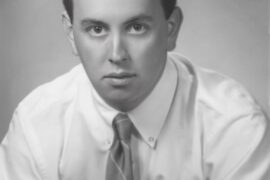Golfing paradise awaits you in the scenic Mountain State
By Jack Houvouras
HQ 32 | SUMMER 1998
West Virginia. The Mountain State. Home of the Hatfields & McCoys. The stereotypes often tell the story. Coal is king, poverty is prevalent and moonshine is a natural resource. But stereotypes often fail to tell the entire story. This is also the home of the Yeagers and Sneads, as in Chuck and Sam. Today, coal has been surpassed by the tourism industry, economic prosperity is dotting the landscape and one of the state’s greatest natural resources is golf.
What kind of golf? The kind of golf that can be found on the only course in the world that bears the legendary Pete Dye name; golf at one of the leading hotels of the world; and golf at what many claim is the birthplace of the game in America.
To see it all, four golfing adventurers (myself, my brother Drew, and photographers David Fattaleh and Stephen Shaluta) set out on a journey we affectionately titled, “West Virginia’s Ultimate Golf Tour.” Over the course of six days, we visited the state’s finest tracts and enjoyed the golf outing of a lifetime.
Before our expedition began, we gathered up our clubs and did some careful planning. Tee times were reserved at each of the seven courses to maximize our golf schedule and minimize our travel time. Our goal was to golf in the morning, travel in the afternoon and relax in the evening.
Day One. We departed from Huntington in the afternoon and arrived at Glade Springs, a four season resort community near Beckley, in time to hit some balls and try a little fishing. Later, we sampled the best steaks in the state at the Char House before hitting the hay early in the Presidential Suites at the resort.
Day Two. Following a good night’s rest, we walked onto the first tee at 8 a.m. and played away. Our group was immediately impressed by the exceptional beauty and playability of the layout. Designed by George W. Cobb in 1974, the course at Glade Springs features 8 lakes, 48 sand bunkers and an array of challenging holes. We were even more impressed when we learned that in 1995, Golfweek magazine ranked Glade Springs the #1 course in West Virginia.
Following an enjoyable morning, we packed up our gear and set out for a short drive to the legendary Greenbrier Resort. A 3:30 p.m. tee time awaited us at The Old White Course. Completed in 1913 by Charles Blair Macdonald, a towering figure in early golf, The Old White incorporates the designs of the most famous holes in Scotland. The layout affords numerous pitch and run shots while scenic mountain vistas await you at every turn. An impressive design, The Old White is a an annual visitor on every golf publication’s list of the “Top 100 Courses in America.”
Following a long second day, the group marveled over a gourmet meal in the main dining room (where we saw golf pro emeritus Sam Snead) before retiring to our luxurious suites in preparation for an early round on The Greenbrier Course.
Day Three. The fog was still lifting when we walked off of the first tee at 8:05 a.m. Originally built in 1924, The Greenbrier Course was completely redesigned by Jack Nicklaus for the 1979 Ryder Cup Matches, which featured the first all-European team. Nicklaus’ influence is notable throughout the heavily wooded terrain which demands forced carries onto greens. The beauty of nature is prevalent on every hole which makes the course all the more enjoyable. After our round, we ran into amateur legend Bill Campbell in the locker room who suggested we drive across town to play Oakhurst Links. Campbell went on to point out that the nine hole course, built in 1884, was arguably the oldest golf course in America. We left our golf shoes on and followed Campbell’s instructions. Our group was welcomed at the club by owner Lewis Keller who handed us five wooden clubs, a few strange looking balls and led us to the first tee. He then stooped over, reached into a bucket of sand, then a bucket of water and manufactured a small tee from the two elements. He took his wooden club and proceeded to place a tee shot right down the middle of the fairway where sheep were grazing. The entire experience, from walking the scenic stretch of land to playing with museum-like clubs to our chat with Keller, was fascinating.
We reluctantly departed from the historic grounds of Oakhurst Links and left for Snowshoe Mountain, home of one of the most acclaimed mountain courses in the country — Hawthorne Valley.
Day Four. Following another restful evening, this time at the Inn at Snowshoe Mountain, we walked onto the first tee of the Gary Player-designed Hawthorne Valley. Hole after hole we stood in awe of the natural beauty that was laid out before us. As Player himself recently said, “You have to see it to believe it.” Golf Digest agreed. The publication listed the course, which winds through the base of Snowshoe Mountain, as “One of the Top 500 Courses in America.”
We then traveled north to Lakeview, a four season resort near Morgantown. At dinner we watched the sun set over Cheat Lake as we discussed our strategy for the next day.
Day Five. Another early morning tee time awaited as well as a thick layer of dark clouds. Our round was highlighted by dramatic holes and beautiful vistas carved from imposing oak forests that blanket the rolling fairways. We managed to squeeze in 17 holes before lightning struck and sent us speeding back to the clubhouse. The day was a success except for our lost opportunity to play the infamous par five 18th which measures 620 yards, uphill. Therefore, no one in our group was able to card a course record 67 shared by Sam Snead, Jack Nicklaus and Orville Moody.
After completing our round we made a short drive to Bridgeport, near Clarksburg, where we arrived at the black iron gates of the Pete Dye Golf Club. A security guard checked our names and waved us through. We caught a glimpse of the course, putted around, enjoyed a leisurely dinner and then retired for the evening in one of the private club’s guest cabins. Little did we know what awaited us the next morning.
Day Six. A four caddie greeted us at the first tee, raced to the edge of the fairway and awaited our tee shots. As we proceeded from hole to hole, it became clear that this course, the only course in the world named after legendary golf architect Pete Dye, the man who molded such revered tracts as Sawgrass, Harbor Town and PGA West, was indeed special. Dye would tend to agree:
“The historical significance of the land,” Dye wrote, “first as an Indian campground then as the site of coal mining operations, is combined with the terrain of the West Virginia hills. This has allowed me to create 18 of the most exciting and memorable holes I have ever built on one course.”
Upon completing our challenging round over long fairways, heavy rough, lakes, streams and surreal greens (we even passed through a deep mine en route from one hole to the next) we packed up our car and began the final leg of the journey — home. The two hour trip was quiet. We were all speechless except for the shared opinion that Pete Dye was, without question, the finest golf course in the state.
And so it was. The grand experiment we referred to as “West Virginia’s Ultimate Golf Tour” not only lived up to our expectations, it surpassed them. The trip offered solid proof that the Mountain State offers golf enthusiasts a little bit of everything. From the history of Oakhurst Links to the majestic beauty of Hawthorne Valley to the legendary work of Pete Dye, golf in West Virginia is indeed, “almost heaven.”





